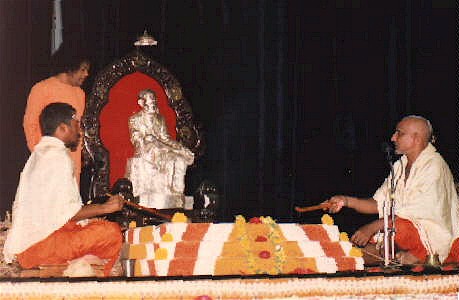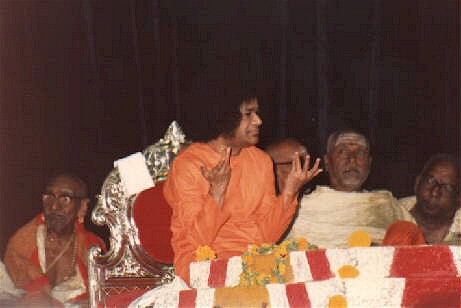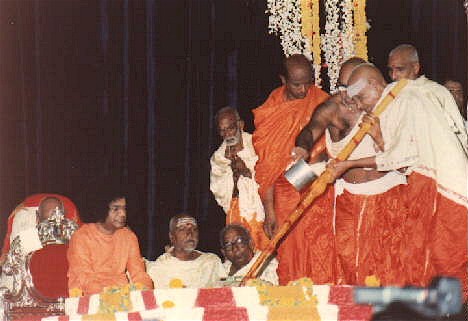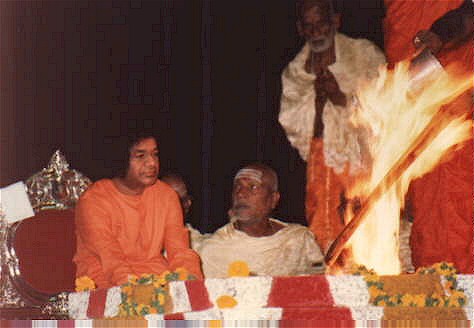
By G.V. SubbaRao
From Sanathana Sarathi, December 1997
(The photographs on this page show scenes from the Veda Purusha Jnana Yajna held in October 1988)
For many years since 1962 Bhagavan Baba has been conducting a Veda Purusha Jnana Yajna for seven days during Dasara for promoting the material and spiritual well-being of mankind. After a break of about three years, the performance of this Yajna was resumed in October this year (1997) in the Poornachandra Auditorium.

Yajna is the means for securing awareness of the Divine. Yajna is governed by mantras, sacrifice and divinity. Hence by performing the Yajna for seven days one secures the two fold well-being ("sreyas") and the awareness of the Divine ("Jnana"). It may be asked why the Yajna should be performed for seven days. The number seven has a special esoteric significance in relation to creation. For instance, there are said to be Seven Worlds (saptha lokas), the Seven Sages, the Seven Seas, the Seven Sacred Mountains, the Seven Swaras (of music), the Seven Colors of the Sun's ray and so on. If these are worshipped as symbols of the Divine, awareness of the Divine arises. By the performance of the Yajna for seven days according to Vedic injunctions, man can acquire the ability to get rid of the seven veils of ignorance, ascend the seven stages of spiritual knowledge and achieve liberation ("Moksha").

Before the commencement of the Yajna, the Vedic Pandits take the prescribed vow to perform the Yajna after chanting the mantras for sanctifying the place of Yajna.
All the Vedic Pandits taking part in the Yajna, wearing the sacred orange robes, arrive in a procession from the Mandir to the Poornachandra Auditorium to the accompaniment of auspicious nadaswaram music and the chanting of Vedic hymns by students.
The Yajna begins with the lighting of the sacred sacrificial fire. The fire is started by the rapid rubbing of two sacred wooden sticks by the priests. The sacrificial fire starts burning by the natural emergence of fire in the latent sticks, symbolic of the latent presence of the Divine in every object in creation. Bhagavan has often declared that if one turns the vision inward he would be able to experience the light Divine effulgent in one's heart.
In this Yajna, seven principal deities are worshipped. Ganesha, Surya (the Sun God), Devi (The Divine Mother), Brahma, Vishnu, Siva and Agni Sakthi. Vedic chants are recited to adore the four-faced Brahma who is the propagator of Vedas. The Fire God (Agni) the transmitter of devotional fire offerings to the Devas, is also propitiated by the offerings to the sacrificial fire. Altogether seven Divine potencies are worshipped. Bhagavan has declared that all these potencies are in man.

Before worship is done to any particular deity the help of Vighneswara is invoked for the prevention of any obstacles to the worship. Ganapathi is worshipped as primary deity who is the embodiment of Pranava (the sacred mantra "Om"). He is the bestower of knowledge and powers of various kinds.
The worship of the Sun-God is an important part of this Yajna. The priest engaged in this Sun-worship repeats the sacred mantras relating to the Sun while offering prostrations (Surya-namaskar) to the Sun-God. The Sun is the bestower of health and is the Lord of all planets in the solar system. The worship is offered not to the physical sun but to the presiding deity, Suryanarayana.
Another important feature of the Yajna is the worship of Devi. She is Parameswari, Chithswarupini and Maayaswarupini. She represents Nature, the Mother of the Universe and is the supreme embodiment of Love. She represents seven material forms of the Divine. In the Yajna, Devi is worshipped by the recitation of Lalitha Sahasranama and the reading of the Devi Bhagavatham.

Vishnu is worshipped in this Yajna by the recitation of Bhagavatham and Purusha Sukta. Vishnu is hailed as the all-pervading Lord of the Cosmos in the Purusha Sukta. The Sage Suka told King Parikshit that by listening to the glories of Vishnu in the seven days given to him before his end, he could attain salvation.
The reading of Valmiki's Ramayana is another significant item in this Yajna. The regular reading of the Ramayana has great value for the spiritual aspirant. In this context, Swami has often stressed the special importance of Sundarakanda in which Valmiki extols the exploits of Hanuman, the Supreme devotee of Rama.
The most important aspect of this Yajna is the worship of Siva. This worship is done by the pooja offered to one thousand lingas of Siva and by the offerings to Siva in the sacrificial fire on all the seven days of the Yajna with the chanting of "Rudram". On the final day of the Yajna, Bhagavan materializes various precious objects and offers them to the sacrificial fire. Bhagavan has declared that what everyone should offer in the sacrificial fire are his bad qualities. Swami has explained that the sacred smoke rising from the sacrificial fire, fully charged with the power of the sacred Vedic mantras, enters the clouds and purifies the rain tailing from them. The smoke of the sacrificial fire thus purifies the pollution in the atmosphere and on earth.
Brahma as Creator is propitiated in this Yajna by the chanting of the Vedas by the Ritwiks. The Vedas are eternal and are the basis for all Dharma. Bharat is esteemed as the soul of the Vedas and the land that gave the Vedas to the world. Bhagavan has proclaimed the glory of the Vedas in many of His discourses.
Pandits who have mastered the Rig and Yajur Vedas had a prominent part in the Yajna. Bhagavan has often emphasized the purifying and sacrificial power of the Vedic mantras.
Bhagavan's discourses during the seven days of the Yajna are veritable spiritual feasts for the devotees. Bhagavan explains in the simplest language profoundest Vedantic Truths so that everyone understands the message of the Advaitic doctrine and the oneness of the individual self and the Supreme Self. This, indeed, is the real purpose of the "Jnana Yajna".

Baba generously honors all the Ritwiks and others participating in the Yajna with gifts of clothes and other things. This year's Veda Purusha Yajna has become one of the most memorable in the annals of Prasanthi Nilayam.